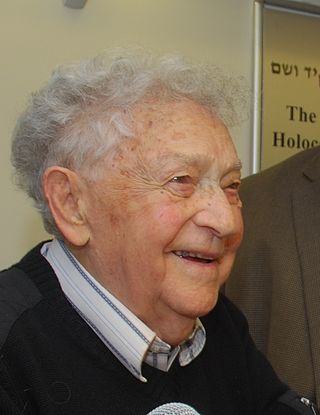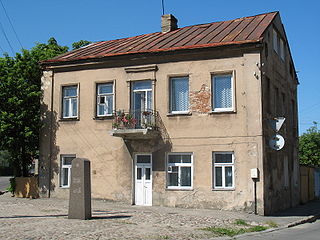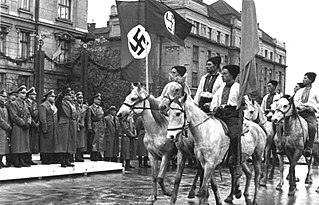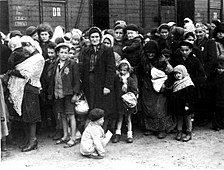
The Final Solution or the Final Solution to the Jewish Question was a Nazi plan for the genocide of individuals they defined as Jews during World War II. The "Final Solution to the Jewish question" was the official code name for the murder of all Jews within reach, which was not restricted to the European continent. This policy of deliberate and systematic genocide starting across German-occupied Europe was formulated in procedural and geopolitical terms by Nazi leadership in January 1942 at the Wannsee Conference held near Berlin, and culminated in the Holocaust, which saw the murder of 90% of Polish Jews, and two-thirds of the Jewish population of Europe.

During World War II, some individuals and groups helped Jews and others escape the Holocaust conducted by Nazi Germany.

Yitzhak Arad was an Israeli historian, author, IDF brigadier general and Soviet partisan. He also served as Yad Vashem's director from 1972 to 1993, and specialised in the history of the Holocaust.
Following the establishment of the Second Polish Republic after World War I and during the interwar period, the number of Jews in the country grew rapidly. According to the Polish national census of 1921, there were 2,845,364 Jews living in the Second Polish Republic; by late 1938 that number had grown by over 16 percent, to approximately 3,310,000, mainly through migration from Ukraine and the Soviet Russia. The average rate of permanent settlement was about 30,000 per annum. At the same time, every year around 100,000 Jews were passing through Poland in unofficial emigration overseas. Between the end of the Polish–Soviet War of 1919 and late 1938, the Jewish population of the Republic grew by nearly half a million, or over 464,000 persons. Jews preferred to live in the relatively-tolerant Poland rather than in the Soviet Union and continued to integrate, marry into Polish Gentile families, to bring them into their community through marriage, feel Polish and form an important part of Polish society. Between 1933 and 1938, around 25,000 German Jews fled Nazi Germany to sanctuary in Poland.

The Iași pogrom was a series of pogroms launched by governmental forces under Marshal and Conducător Ion Antonescu in the Romanian city of Iași against its Jewish community, which lasted from 29 June to 6 July 1941. According to Romanian authorities, over 13,266 people, or one third of the Jewish population, were massacred in the pogrom itself or in its aftermath, and many were deported. It was one of the worst pogroms during World War II.

The Fareynikte Partizaner Organizatsye was a Jewish resistance organization based in the Vilna Ghetto in Lithuania that organized armed resistance against the Nazis during World War II. The clandestine organisation was established by communist and Zionist partisans. Their leaders were writer Abba Kovner, Josef Glazman and Yitzhak Wittenberg.

The Kovno Ghetto was a ghetto established by Nazi Germany to hold the Lithuanian Jews of Kaunas (Kovno) during the Holocaust. At its peak, the ghetto held 29,000 people, most of whom were later sent to concentration and extermination camps, or were shot at the Ninth Fort. About 500 Jews escaped from work details and directly from the ghetto, and joined Jewish and Soviet partisan forces in the distant forests of southeast Lithuania and Belarus.

The Vilna Ghetto was a World War II Jewish ghetto established and operated by Nazi Germany in the city of Vilnius in the modern country of Lithuania, at the time part of the Nazi-administered Reichskommissariat Ostland.

Jewish resistance under Nazi rule took various forms of organized underground activities conducted against German occupation regimes in Europe by Jews during World War II. According to historian Yehuda Bauer, Jewish resistance was defined as actions that were taken against all laws and actions acted by Germans. The term is particularly connected with the Holocaust and includes a multitude of different social responses by those oppressed, as well as both passive and armed resistance conducted by Jews themselves.

Jewish partisans were fighters in irregular military groups participating in the Jewish resistance movement against Nazi Germany and its collaborators during World War II.
Holocaust victims were people targeted by the government of Nazi Germany based on their ethnicity, religion, political beliefs, and/or sexual orientation. The institutionalized practice by the Nazis of singling out and persecuting people resulted in the Holocaust, which began with legalized social discrimination against specific groups, involuntary hospitalization, euthanasia, and forced sterilization of persons considered physically or mentally unfit for society. The vast majority of the Nazi regime's victims were Jews, Sinti-Roma peoples, and Slavs but victims also encompassed people identified as social outsiders in the Nazi worldview, such as homosexuals, and political enemies. Nazi persecution escalated during World War II and included: non-judicial incarceration, confiscation of property, forced labor, sexual slavery, death through overwork, human experimentation, undernourishment, and execution through a variety of methods. For specified groups like the Jews, genocide was the Nazis' primary goal.

Ukrainian collaboration with Nazi Germany took place during the occupation of Poland and the Ukrainian SSR, USSR, by Nazi Germany during the Second World War.
Responsibility for the Holocaust is the subject of an ongoing historical debate that has spanned several decades. The debate about the origins of the Holocaust is known as functionalism versus intentionalism. Intentionalists such as Lucy Dawidowicz argue that Adolf Hitler planned the extermination of the Jewish people as early as 1918, and personally oversaw its execution. However, functionalists such as Raul Hilberg argue that the extermination plans evolved in stages, as a result of initiatives that were taken by bureaucrats in response to other policy failures. To a large degree, the debate has been settled by acknowledgement of both centralized planning and decentralized attitudes and choices.

The Holocaust in Lithuania resulted in the near total eradication of Lithuanian (Litvaks) and Polish Jews in Generalbezirk Litauen of the Reichskommissariat Ostland in the Nazi-controlled Lithuania. Of approximately 208,000–210,000 Jews at the time of the Nazi invasion, an estimated 190,000 to 195,000 were killed before the end of World War II, most of them between June and December 1941. More than 95% of Lithuania's Jewish population was murdered over the three-year German occupation, a more complete destruction than befell any other country in the Holocaust. Historians attribute this to the massive collaboration in the genocide by the non-Jewish local paramilitaries, though the reasons for this collaboration are still debated. The Holocaust resulted in the largest loss of life in so short a period of time in the history of Lithuania.
The Holocaust in Belarus refers to the systematic extermination of Jews living in the Byelorussian Soviet Socialist Republic during its occupation by Nazi Germany in World War II. It is estimated that roughly 800,000 Belarusian Jews were murdered during the Holocaust. However, other estimates place the number of Jews killed between 500,000 and 550,000.

The Holocaust in Ukraine was the systematic mass murder of Jews in the Reichskommissariat Ukraine, the General Government, the Crimean General Government and some areas which were located to the East of Reichskommissariat Ukraine, in the Transnistria Governorate and Bessarabia, Northern Bukovina and the Hertsa region and Carpathian Ruthenia during World War II. The listed areas are currently parts of Ukraine.

The Holocaust in German-occupied Serbia was part of the European-wide Holocaust, the Nazi genocide against Jews during World War II, which occurred in the Territory of the Military Commander in Serbia, the military administration of the Third Reich established after the April 1941 invasion of Yugoslavia. The crimes were primarily committed by the German occupation authorities who implemented Nazi racial policies, assisted by the collaborationist forces of the successive puppet governments established by the Germans in the occupied territory.

The Kielce Ghetto was a Jewish World War II ghetto created in 1941 by the Schutzstaffel (SS) in the Polish city of Kielce in the south-western region of the Second Polish Republic, occupied by German forces from 4 September 1939. Before the Nazi invasion of Poland in 1939, Kielce was the capital of the Kielce Voivodeship. The Germans incorporated the city into Distrikt Radom of the semi-colonial General Government territory. The liquidation of the ghetto took place in August 1942, with over 21,000 victims deported to their deaths at the Treblinka extermination camp, and several thousands more shot, face-to-face.
Szczuczyn pogrom was the massacre of some 300 Jews in the community of Szczuczyn carried out by its Polish inhabitants in June 1941 after the town was bypassed by the invading German soldiers in the beginning of Operation Barbarossa. The June massacre was stopped by German soldiers after Jewish women bribed them to intervene.

Baranavichy Ghetto was a ghetto created in August 1941 in Baranavichy, Belarus, with 8,000 to 12,000 Jews suffering from terrible conditions in six buildings. From March 4 to December 14, 1942, Germans killed nearly all of the Jews in the ghetto. Only about 250 survived the war, some of whom were helped by Hugo Armann, head of a unit that arranged travel for soldiers and security police. He saved six people from a murder squad and another 35 to 40 people who worked for him. Edward Chacza coordinated escapes with Armann and others so that Jews would meet up with partisan groups in the forest. He also provided food and arms.














